Owners of private houses pay more and more attention to the issue of environmental friendliness of future construction. An original and aesthetic solution will be the choice in favor of a green roof. This type of roofing used to be used in countries with warm climates. But now it has become a trend and is used to create cozy places where you can relax and enjoy the clean air. Many are interested in the question of how to make an eco-friendly and aesthetic roof with your own hands.
Content
general description
Advantages:
- Environmental friendliness. A green coating will saturate the air with oxygen.
- Soundproofing. Thanks to the thick layer of the roof covering, the green roof will protect against possible noise.
- Thermal insulation.
- The site will be noticeably less dusty.
- A green roof will protect the roofing cake from damage.
- Unusual appearance.
At the moment, green roofs are divided into two types:
- Extensive. The choice in favor of this type will be optimal for cases where there is a need to reduce time and effort when caring for the roof. The roof slope for the device of such a system should be no more than 45 degrees. Suitable for those places where there are no roof exits: for example, at industrial facilities, shopping centers, terraces, garages, gazebos, bus stops.
For the device of such a roof, perennial plants of various varieties that are unpretentious in maintenance are suitable - frequent watering or cutting is not required. It is important that these plants tolerate winter well.
- Intensive. The advantage of this type is the possibility of exploitation. You can apply for any buildings. The most popular is the organization of the roof of a private house. For such a roof, it is necessary to lay the tracks. The presence of trees and shrubs is also welcome, you can organize a rooftop garden, providing it with lighting and watering. You can also leave space for multi-tiered flower beds, alpine slides and ponds.
An intense green roof will not only allow you to relax from the hot weather in the shade of the garden, but also lower the temperature in the room. The protection from the scorching sun will be a layer of soil and greenery. On the roof you can place furniture: chairs, tables, a deck chair.
When installing a green roof, one must not forget about some requirements:
- Ensuring safe operation. To do this, it is necessary to provide parapets and fences with a height of at least 120 centimeters. They must support the weight of the people on it. It is important to provide for the installation of special fortifications and wind shields.
- As materials should be selected environmentally friendly.
- It is important to protect the supporting structure from damage due to corrosion or mold.
- It is necessary to provide isolation for the roots of plants.
- Do not go beyond the values of the loads on the supporting system. Both static and dynamic loads should be considered.
- When arranging utility rooms, for example, to store inventory, their weight should be taken into account when calculating.
It is better to determine the type of roof when designing a house in order to make all the necessary calculations of loads even at the planning stage. This should be done to avoid cracking on the supporting structures. If this is not possible, then when organizing a green roof, it is still necessary to make calculations to make sure the structure is strong. If it is not enough, then it is better to strengthen the supporting structure before the roof device.
DIY roof gardening
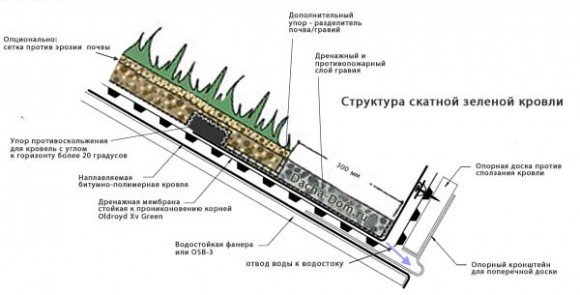
It is worth noting that container gardening, when plants are placed in pots or crates, has nothing to do with a green roof.
To make roof gardening an extensive method, it is necessary to pay attention to several factors: stability, strength and condition of the roof. The possible thickness of the soil is calculated based on the strength of the overlap. The choice of plants will depend on this, because they also have weight. A reinforced concrete structure is best suited for these purposes. It will provide an opportunity not only to create soil soil of 40-50 centimeters, but also to plant shrubs and trees. If you are not sure about the strength of your roof, then you should think about organizing a “carpet” containing various cleanings, saxifrages, and youngs. A soil layer can be made 5 centimeters.
Layers of green roof
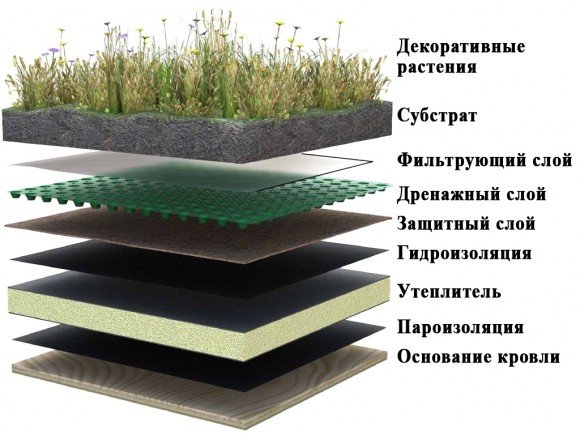
- Waterproofing.
Plant care involves the use of water, watering plants. But such a green roof care can be detrimental to the roof structure. To avoid this, use a waterproofing layer, which is used as a plastic film, liquid rubber, polymer membranes, etc. For the proper waterproofing device, it is laid on the existing roof covering. If it is not, then it is necessary to ensure the presence of a continuous crate.
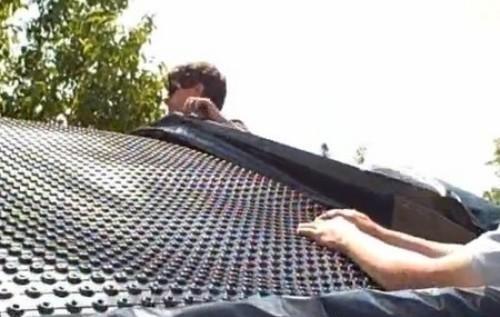
- Root barrier
It is placed on top of the waterproofing layer to ensure its protection against germinating roots. As such a barrier, a foil or a polymer film is suitable. You can use special waterproofing, which has anti-root additives. They do not allow the root to grow into the material, damaging it. A root barrier may not be necessary if you have chosen the ground cover type as a plant for sowing: for example, sedum or lawn grass.
- Drainage layer
Drainage allows you to distribute water on the surface. At the same time, he retains part of the water, and directs excess moisture to the drain. For sloping roofs, the issue of water flow is solved naturally - only openings are provided at the corners of the roof. For a flat roof, everything is more complicated. Before the waterproofing device, surface profiling is provided to prevent stagnation of water. Expanded clay of medium and large fractions can become lower drainage. You can use special artificial mats. They provide excellent moisture retention for plants, without interfering with the excess water leaving the drain. An example is geomats. They are a coarse washcloth, consisting of plastic flexible mesh grids.
- Filtration layer
Its purpose is to protect the drainage from clogging. He is able to delay unwanted precipitation from the ground. Geotextiles are the most common material for the filtration layer. Geofence helps to avoid mixing soil and drainage, which can happen over time.
- Geogrid
It is used only for flat roofs with a slope of more than 25 degrees, because the fixation of the soil is mandatory to prevent its slipping. The geogrid has a small weight. Outwardly, it looks like a cellular structure made of plastic. With small deviations of the roof, they usually cost with wooden partitions. They can be used as an aesthetic addition, laying them out in the form of a geometric ornament. It is also necessary to provide for the presence of wooden boards along the perimeter to provide a fastening border.
- Fertile substrate
The thickness of the soil layer depends on the choice of the type of plants planted on the roof. For example, lawn grass and ground cover types will comfortably grow with a soil thickness of 5-10 centimeters. If you set out to grow a full-fledged garden on the roof, then it is necessary to provide a soil layer of 1 meter. There are a number of requirements for soils.Light by weight, medium in mechanical composition, porous, moisture-intensive, with neutral peat suitable with fertilizers or mixed with fine expanded clay are suitable. Provided that the floor structure is sufficiently strong, use light soil, adding expanded clay (15-20%) to it. In the case of roof sagging, the top layer of the substrate is mixed with grass seeds.
Plant selection
Criteria:
- small root system;
- frost and drought resistance;
- resistance to temperature extremes;
- not requiring careful care.
Most often, for the purpose of landscaping the roof, saxifrage, thyme, sage, young growth, rough cattle, small onion flowers, etc. can be used. You can also use moss and lichen, provided that the house is in the shade.
When choosing trees or shrubs, it is recommended to stay on a birch saggy, common pine, European larch, purple willow, mountain pine, Tunberg barberry, gray spirea and shrubby cinquefoil.
For a roof with a turf base, it is better to use dwarf or creeping shrubs and trees, unpretentious herbs and vines and plants that densely cover the soil. Thanks to small-beam daffodils, crocuses, scylls and muscars, it is possible to provide landscaping in the spring.
Green Roof Gallery
Video: the stages of the erection of the green roof
//www.youtube.com/watch?v=9V6PpRDKcso

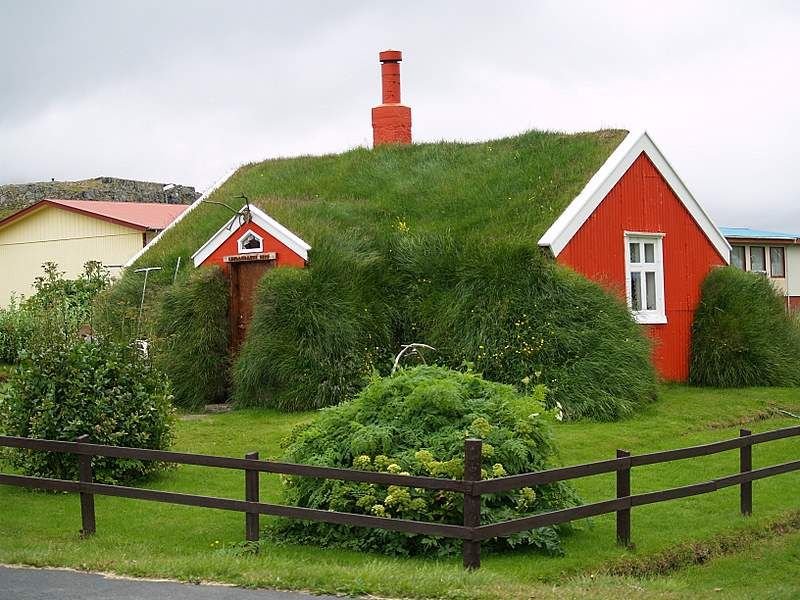
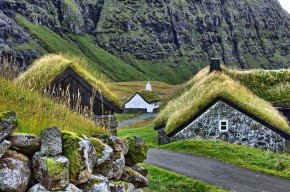

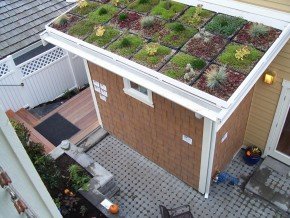
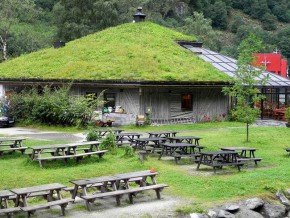
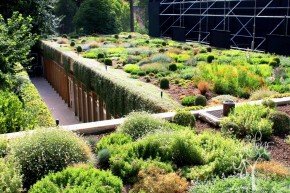
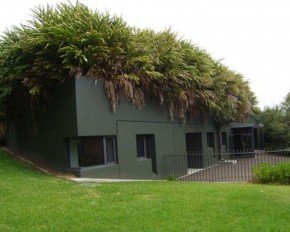



Alas, no comments yet. Be the first!